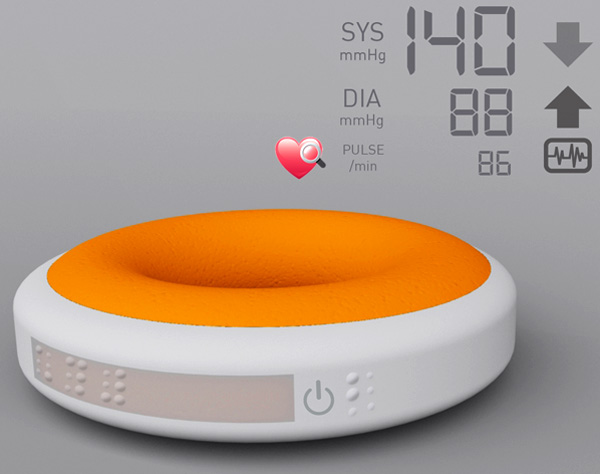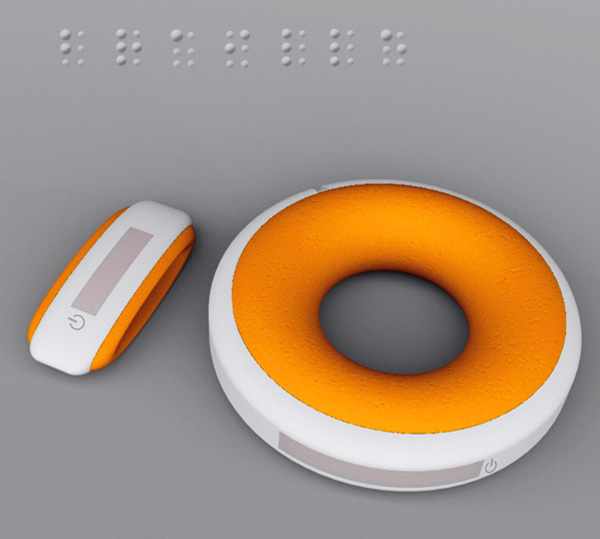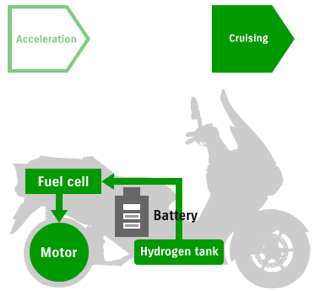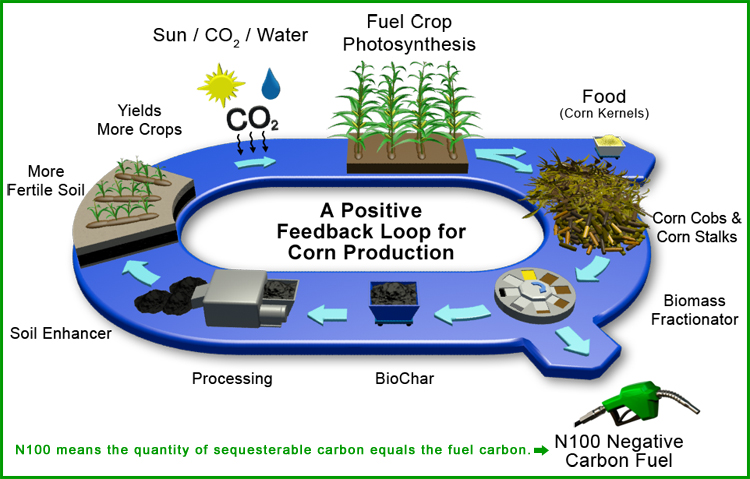Clever Flatpack Furniture is FOBricated With Ratchet Straps
by: TreeHugger Design, 2011-03-21 14:15:00 UTC

Images credit Jason Barbagelott at
FOBricated
TreeHugger founder Graham Hill is looking for furniture for the
LifeEdited project; this line from
FOBricated might fill the bill. It is as minimal as it gets, held together in tension by ratchet straps. The designers tell Mocoloco that ""They all follow the same principles of construction, using no nails, screws or other typical woodworking hardware."
...
Read the full story on TreeHugger
Blood Pressure Bracelet
by: Yanko Design, 2011-03-17 15:57:14 UTC
Tensio is an electronic blood pressure reading bracelet designed to keep tabs on your vital signs without appearing to be an medic-alert device. The core is cushioned with inflatable foam to take the reading and results appear on a display or through a tactile, braille surface. In case of emergencies, Tensio can wirelessly call for help.
Designer: Diana Dumitrescu




----------
Yanko Design
Timeless Designs - Explore wonderful concepts from around the world!
Yanko Design Store - We are about more than just concepts. See what's hot at the YD Store!
China, Malaysia Become Latest Nations to Ban BPA
by: Greener Design, 2011-03-15 12:00:00 UTC
China and Malaysia have added to the list of countries setting bans on the estrogen-mimicking chemical bisphenol A.

 Big Brands Launch Sustainable Packaging Trade Group
Big Brands Launch Sustainable Packaging Trade Group
by: Greener Design, 2011-03-14 12:45:39 UTC
Big-name companies such as ConAgra, Colgate-Palmolive, Kellogg, Procter & Gamble, DuPont and Dow Chemical formed a new lobbying organization to give industry a voice on policy issues related to sustainable packaging.

 The Balancing Act of Finding and Fighting Chemical Risks
The Balancing Act of Finding and Fighting Chemical Risks
by: Greener Design, 2011-03-16 19:09:25 UTC
Balancing the various effects of chemicals, along with performance needs, poses challenges for companies cleaning up their products.

 New Shock Wave Engines Have the Potential to Triple Fuel Efficiency in Hybrid Vehicles
New Shock Wave Engines Have the Potential to Triple Fuel Efficiency in Hybrid Vehicles
by: Inhabitat , 2011-03-18 13:45:37 UTC

We’ve seen a number of innovations focused on improving the efficiency of hybrid cars. But while most of these new ideas have focused on optimizing battery capacity, here is one new piece of technology that is about to revolutionize the engine itself. Straight from the engineers at Michigan State University, this new ‘wave disk engine’ is 3.5 times more fuel efficient than a conventional combustion engine, can be run on almost any fuel and emits 95% less carbon dioxide.
Read the rest of New Shock Wave Engines Have the Potential to Triple Fuel Efficiency in Hybrid Vehicleshttp://www.inhabitat.com/wp-admin/ohttp://www.inhabitat.com/wp-admin/options-general.php?page=better_feedptions-general.php?page=better_feed
Permalink |
Add to
del.icio.us |
digg
Post tags: clean engines, clean fuel, combustion engine, Department of Energy, efficiency of hybrid cars, green technology, Michigan State University, vlean burning energy, wave disk engine
Two-Wheel Tech: Suzuki Revs Up Fuel-Cell Scooter
by: fast company, 2011-03-18 18:45:48 UTC
The eco-friendly hybrid scooter recently passed a regulatory hurdle in the EU--the first vehicle of its kind to do so.

This scooter from Suzuki, the Suzuki Burgman Fuel-Cell Scooter, recently revved closer to the showroom floor. The scooter, which uses a PEM fuel cell from the British company Intelligent Energy (together with a lithium-ion battery), just received "whole vehicle type" approval in the EU. It's the first fuel cell vehicle to earn that distinction in Europe. It follows over a year of trialling on public U.K. roads by Britain's Technology Strategy board.
 The fuel-cell Burgman is a hybrid, and functions differently depending on whether you're accelerating (drawing on both battery and fuel cell), cruising (mainly the cell), or idling. Range is often an issue for scooters, but Suzuki says the scooter can do 217 miles on a single tank--that's over four times the typical range. (Click here for an interactive slideshow on how the Burgman works.) Fuel cells are eco-friendly, emitting only water. But a hydrogen fueling infrastructure would be needed to make the technology widely adopted.
The fuel-cell Burgman is a hybrid, and functions differently depending on whether you're accelerating (drawing on both battery and fuel cell), cruising (mainly the cell), or idling. Range is often an issue for scooters, but Suzuki says the scooter can do 217 miles on a single tank--that's over four times the typical range. (Click here for an interactive slideshow on how the Burgman works.) Fuel cells are eco-friendly, emitting only water. But a hydrogen fueling infrastructure would be needed to make the technology widely adopted.
The market for scooters in the Americas and Europe has grown dramatically over recent years, according to Pike Research. When the fuel-cell Burgman was first unveiled in 2009, it was a hot moment for scooters, says Pike. But it still stands to be released in a receptive market, and soon: "The fact that Suzuki went to the trouble of securing this EU-wide certification even while the scooter is only in U.K. based trials suggests that the company is still on track for a mid-decade commercial launch," in Pike's assessment.
Follow Fast Company on Twitter.
[Image: Suzuki]


 Google Cash Powers Up CoolPlanet Biofuels
Google Cash Powers Up CoolPlanet Biofuels
by: fast company, 2011-03-18 21:54:31 UTC

CoolPlanet Biofuels, a startup that churns out biofuel from cellulosic waste (think plant waste and woodchips) just snagged an undisclosed amount of cash from Google Ventures in its Series B round of funding. This comes after an $8 million funding round last year, which included GE and North Bridge Venture Partners. Out of all the biofuel players in the market, why is CoolPlanet getting so much attention?
CoolPlanet claims that it can develop "carbon-negative fuels" that can replace gasoline found in cars in the road today. The company's secret sauce is a thermal/mechanical processor that extracts hydrocarbons from biomass, leaving behind excess carbon in solid form. That biochar can be sequestered and used as a soil conditioner or burned as a coal substitute. CoolPlanet explains:
The process generates activated carbon with a very high
surface area which will allow it to be used as a soil enhancer similar
to "terra preta." By burying this carbon in an appropriate manner, we
can greatly enhance soil fertility while sequestering carbon for
hundreds of years. In contrast, normal plant decomposition occurs in
just a few years, releasing the plant's carbon as CO2
and even more harmful methane gas. Our process yields about the same
amount of carbon as gasoline so, if we sequester this carbon as a soil
enhancer, or simply bury it as coal, the associated fuel has a N100 Negative Carbon Rating.

This fits right into Google Ventures's motto of investing in disruptive companies that change the world for the better. Other companies (including Carbonscape) produce biofuel with a biochar byproduct, but CoolPlanet is by far the most prominent. And with a global fuel market of $4 trillion each year, there is plenty of money to be made.
Google Ventures's other environmentally related investments include WeatherBill, Next Autoworks, and Silver Spring Networks.
Follow Fast Company on Twitter. Ariel Schwartz can be reached by email.
Read More: Most Innovative Companies: Google


 Free Tool to Help Companies With Local Water Challenges
Free Tool to Help Companies With Local Water Challenges
by: Environmental Leader, 2011-03-18 06:23:22 UTC

 The Global Environmental Management Initiative (GEMI) is developing a free tool to help companies understand their local water challenges.
The Global Environmental Management Initiative (GEMI) is developing a free tool to help companies understand their local water challenges.
GEMI, whose members include Johnson & Johnson, ConocoPhillips, Dupont, FedEx and other major multinationals, is developing the GEMI Local Water Tool with fellow environmental business group the World Business Council for Sustainable Development (WBCSD).
The downloadable module will be made available by early 2012. It is designed to be used in conjunction with the WBCSD’s Global Water Tool, and the two will be fully compatible, the two organizations said. The Global Water Tool allows for a comprehensive water risk assessment across a company’s portfolio, while the Local Water Tool will provide guidance on local, site-specific water risks and opportunities.
The Local Water Tool is being led by three co-chairs: Karl Fennessey, director of water and biodiversity at ConocoPhillips; Bill Lechner, vice president of global environment health and safety and security at the Scotts Miracle-Gro Company; and Maurice (Moe) Bechard, vice president of global environment health and safety at Diversey, Inc.
“We are excited about the development of this tool because the purpose and functionality of the GEMI and WBCSD tools are mutually supportive,” said Lechner. “Companies can utilize the WBCSD Global Water Tool to identify and prioritize risks in their portfolios. Companies can then employ the GEMI Local Water Tool to further evaluate the high risk locations and plan actions to manage the risks.”
“If companies today expect to compete and succeed in an increasingly water-constrained world, proactive water management must become a core competency,” WBCSD president Bjorn Stigson said. “It is a fundamental truism that you can’t manage what you can’t measure. That is why we have partnered with GEMI to ensure that companies have access to a variety of tools that can be integrated into a comprehensive water management solution.”
GEMI also has a Business and Climate web tool that allows business to share practices on battling climate change. The WBCSD is one of the organizations that created the Scope 1, Scope 2 and Scope 3 protocols for greenhouse gas reporting.
The project represents the first time that companies that are not members of GEMI can participate in the development of a GEMI tool, the organization said. Companies that have joined the effort to develop the tool include AkzoNobel; BP; Chesapeake Energy; Chevron; ENI; ExxonMobil; Greif; Intel; ITT; Maersk Oil & Gas; Nexen Inc.; Shell; Statoil; Suncor Energy Inc.; Talisman Energy Inc.; and TOTAL.
GEMI members include: 3M; Abbott; Biogen Idec; BNSF Railway Company; Cargill, Inc.; Carnival Corporation & plc; ConAgra Foods; ConocoPhillips; CSX Transportation; Diversey, Inc.; DuPont; FedEx; Johnson & Johnson; Johnson Controls, Inc.; Kraft Foods Inc.; Legrand; MedImmune; Merck & Company, Inc.; Occidental Petroleum Corporation; Perdue Incorporated.; The Procter & Gamble Company; The Scotts Miracle-Gro Company; Smithfield Foods, Inc.; Southern Company; and, Union Pacific Railroad.
Picture credit: Michael Scott | scottphotographics.com
 Walmart Waste Program Diverts Over 80%, Expanding Nationwide
Walmart Waste Program Diverts Over 80%, Expanding Nationwide
by: Environmental Leader, 2011-03-18 16:20:54 UTC

 Walmart’s California operations have diverted more than 80 percent of their waste from landfills, and the program that produced these results is being implemented across all of the company’s 4,400 stores, Walmart said yesterday.
Walmart’s California operations have diverted more than 80 percent of their waste from landfills, and the program that produced these results is being implemented across all of the company’s 4,400 stores, Walmart said yesterday.
The program will be put in place in all Walmarts, Sam’s Clubs and Walmart distribution centers in the U.S. Extending the 80 percent diversion rate across the country will help Walmart prevent more than 11.8 million metric tons of carbon dioxide emissions a year, equivalent to taking more than 2 million cars off the road, the company said.
The retailer said its eventual goal is to create zero waste.
“We are proud of the progress we are making toward our zero waste goal, but realize we still have more work to do,” Walmart U.S. president and CEO Bill Simon said. “We are committed to actively finding and developing solutions that are both good for the environment and good for business.
“Through this program we are able to provide the raw materials needed to make new products, recycle millions of pounds of commodities and reduce the environmental impact of landfills,” Simon added.
Walmart began implementing and tracking its waste reduction efforts in California in 2009. The California initiative has three main components: recycling, re-use and donations.
The company recycles cardboard, paper, aluminum, plastic bags and roughly 30 other items through its “super sandwich bale” (SSB) program. In sandwich baling, loose plastic such as shrink wrap, garment bags and grocery bags are sandwiched between layers of cardboard and bundled together in bales, which are sent to certified processors for recycling. This process prevents millions of pounds of trash from being sent to the landfill and saves Walmart millions of dollars, the company says.
Items not eligible for the SSB, including wood pallets, polystyrene plastic and apparel, are sent to Walmart’s return centers for reuse or recycling. Styrofoam gets recycled into photo frames, which are then sold at Walmart stores. Last year, Wal-Mart launched a program with pet product manufacturer Worldwise, to recycle plastic bottles, hangers, bags and cardboard into items such as dog beds, litter boxes and scratching boards.
Wal-Mart also uses expired food to create animal feed, compost, and biofuel for energy production.
Walmart’s food donation program is already underway around the country, and the company says that in 2010, it donated 256 million pounds of food to hunger relief organizations. This is the equivalent of 197 million meals, the company says. By 2013, the company expects to donate more than 1.1 billion pounds of food.
Walmart also works with suppliers to reduce their packaging and increase recyclability. Reducing packaging on one of its patio sets helped Walmart use 400 fewer shipping containers, the retailer says. Collaboration with a toy supplier helped to reduce the packaging on 16 items, using 230 fewer shipping containers, saving about 356 barrels of oil and keeping 1,300 trees from being felled. This initiative will be broadened to 255 items, Walmart says.
“Walmart is to be commended for making real progress in minimizing the environmental impact of waste from its stores,” said Karen Luken, director of the Clinton Climate Initiative’s (CCI) Waste Program. “One of the key aims for CCI’s Waste Program is to reduce methane emissions from landfills, and Walmart’s initiative sends a clear message to other businesses that this is one source of emissions that can and should be addressed now.”
A video about Walmart’s waste-reduction efforts in California is available here.








Comments by our Users
Be the first to write a comment for this item.